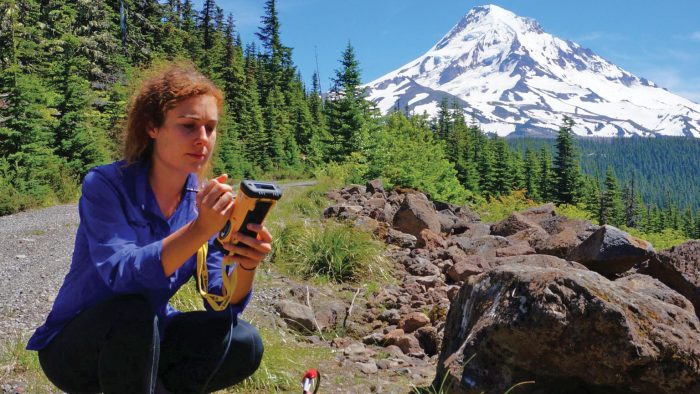 Natural Sciences
Natural Sciences
Did You Feel That?

Tiny earthquakes move through the Pacific Northwest every day, their vibrations detected by only the most sensitive seismic instruments.
They’re caused by the ongoing, slow-motion collision of two planetary plates just off the coast. That geologic smashup has produced staggeringly powerful quakes in the past and will do so again.
In fact, the mini-temblors might be able to tell us what to expect when the next Big One strikes. That’s why Geena Littel (above) is studying them closely.
The earth sciences major is an enthusiastic student of earthquake phenomena, and this inspired assistant professor Amanda Thomas to put her to work on a project with regional ramifications: determining where the shaking will be worst during the next major earthquake in the Pacific Northwest.
Severe earthquakes occur only rarely in the region—the last major one happened in 1700, with an 8.7 to 9.2 magnitude. This infrequency means geologists have little to work with in predicting what the ground will do when the next big temblor hits.
But the Northwest has scores of almost-imperceptible mini-quakes—there were 150 in the first half of July 2017 alone. With hyper-sensitive equipment, geologists are capturing the slightest rumblings that happen anywhere between Northern California and British Columbia, with the ability to measure the source location and depth underground.
As an earthquake’s shock waves radiate outward, the rate at which those waves weaken is determined in part by the ground through which they move—whether it’s dense or loose rock, or saturated with geothermal fluids, for example.
Littel is writing a computer program to describe how mini-temblors are affected by the composition of the earth; from that, she can project the potential power of a major quake underneath Portland or Seattle. An area that has a major dulling effect on the small quakes, she said, might not shake as much during a big one.
With three years of data on 180,000 mini-quakes at her disposal, Littel first isolated the biggest events and filtered out statistical “noise” such as the vibrations from a passing truck. But she ran into trouble with the computer coding to calculate mini-quake behavior in the region.
Through Thomas, Littel connected with a leading geologist for help. Geophysicist Annemarie Baltay is an expert on tremors with the US Geological Survey in Menlo Park, California, and Littel visited her this year. Baltay is part of a team that used small quakes to develop a formula for predicting the impact of a major temblor along the Pacific coast of North America.
With Baltay’s guidance, Littel returned to Eugene and adjusted her computer program so that it would reproduce, for her study area, readings of mini-quake behavior that matched Baltay’s results. She joked that Thomas—whose office is two doors down from the lab in which Littel works—surely heard her exclamations of joy on the day that everything worked perfectly.
It had taken a year, but Littel finally had a reliable tool for answering her original question—how might a big quake behave in the Pacific Northwest?
And she is hard at work formulating an answer, dividing the region into bands of similar geological composition. Next, she’ll use her model to determine how different areas affect the mini-quakes; then she’ll be able to project what the ground will do—and where it will shake the most—during a major event.
After that, it’s just a matter of waiting.
—Jim Murez
Photo credit: Emily Sexton


 Twitter
Twitter Facebook
Facebook Forward
Forward